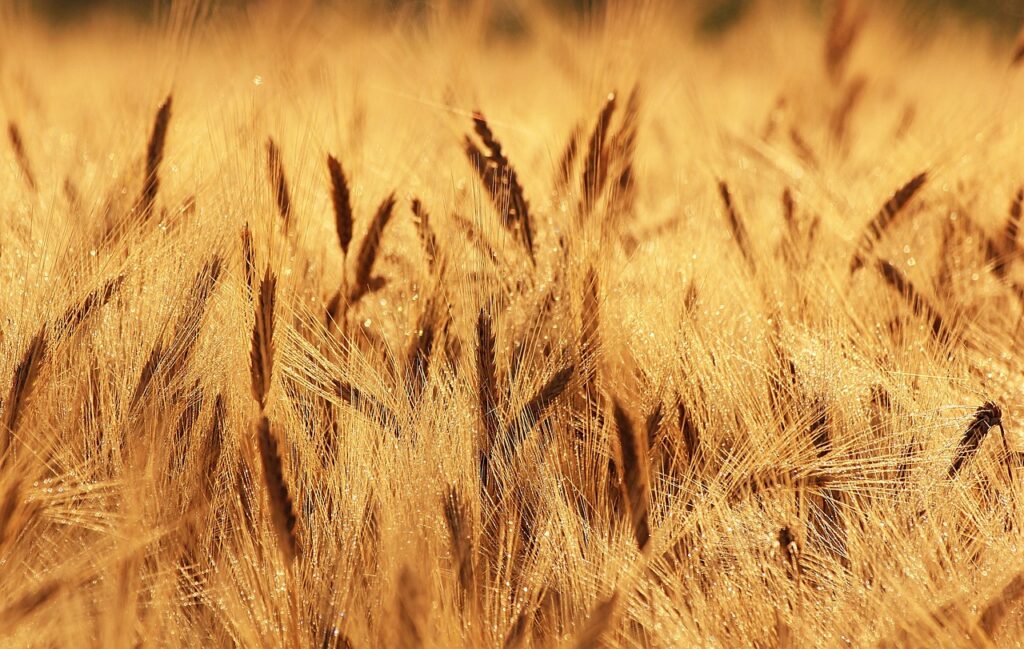. Wheat .


DESCRIPTION
Wheat cultivation in India has traditionally been dominated by the northern region of India. The northern states of Punjab and Haryana Plains in India have been prolific wheat producers. While this cereal grass has been studied carefully in the past, recent years of painstaking research by India’s finest scientific talent have paid off with the development of distinctly superior varieties of Durum Wheat.
This hard wheat is cultivated in clayey soil and is highly sought after for its physical characteristics. Its high gluten strength and uniform golden color make it ideal for bread making and pasta preparation unlike the softer commercially high-yielding wheat, which lacks the strength and consistency of durum. Today, India is exporting sufficient quantities of all types of wheat and extensive research efforts are underway for improving its cereals and grain output in the years to come. Wheat cultivation has traditionally been dominated by the northern region of India.
USES
Wheat is typically milled into flour which is then used to make a wide range of foods including bread, crumpets, muffins, noodles, pasta, biscuits, cakes, pastries, cereal bars, sweet and savoury snack foods, crackers, crisp-breads, sauces and confectionery (e.g. liquorice). Other culinary applications of wheat include:
- Flaked, puffed and extruded wheat – all three forms are commonly used to manufacture breakfast cereals and cereal snack bars.
- Wheat bran – added to biscuits, cakes, muffins and breads to increase the dietary fibre content. Wheat bran is also used in the manufacture of some breakfast cereals.
- Wheat germ – can be added to breads, pastries, cakes and biscuits or sprinkled onto yoghurt, breakfast cereal or fruit dishes.
- Semolina – mainly used for making pasta. The preferred variety of wheat for pasta is Triticum durum. It can also be cooked in milk to make semolina pudding or fried golden brown and then mixed with plenty of sugar to make Halva, as eaten in the Middle East. In Greece, semolina is used in baked cakes.
- Cous cous – used widely in North Africa, cous cous is made from semolina grains which are sprinkled with slightly salted water and rubbed to make tiny pellets which are steamed and then dried. Instant couscous is available in Australia which needs only 5 minutes soaking in hot water.
- Burghul (also known as bulgur or cracked wheat) – is made by parboiling wheat, drying it and then coarsely grinding it. It can be steamed or boiled and used in a wide range of dishes, such as tabouleh, kofta or kibbeh.
- Kibbled wheat – grains are cracked or broken into smaller particles and then moistened or steamed and dried. Kibbled wheat is used as an ingredient in mixed grain bread or cooked as a side dish.
- Boiled wheat – puddings are made from boiled wheat in Lebanon and the Balkans.
- Wheat starch – used as ‘cornflour’ or converted to glucose, dextrose and other sugars for use in confectionery and other manufactured foods.
. Maize (Corn) .

DESCRIPTION
Maize (Zea mays L.) is one of the most versatile emerging crops shaving wider adaptability under varied agro-climatic conditions. Globally, maize is known as the queen of cereals because it has the highest genetic yield potential among the cereals. It is cultivated on nearly 190 m ha in about 165 countries having wider diversity of soil, climate, biodiversity and management practices that contributes to 39 % of the global grain production. The United States of America (USA) is the largest producer of maize contributes nearly 30.99% of the total production in the world in 2020 and maize is the driver of the US economy. In India, Maize is grown throughout the year. It is predominantly a Kharif crop with 85 percent of the area under cultivation during the season. Maize is the third most important cereal crop in India after rice and wheat. It accounts for around 10 percent of total food grain production in the country. India is also the fifth largest producer of Maize in 2020 as per FAO data and India’s share in world production accounted to be 2.59 per cent in the same year.
USES
In addition to staple food for human being and quality feed for animals, maize serves as a basic raw material as an ingredient in thousands of industrial products that includes starch, oil, protein, alcoholic beverages, food sweeteners, pharmaceutical, cosmetic, film, textile, gum, package and paper industries, etc.
. Barley .



DESCRIPTION
Barley, Hordeum vulgare, is an edible annual grass in the family Poaceae grown as a cereal grain crop. It is a tall grass with a hairy stem which stands erect and produces spikelets at the head. The stem is made up of nodes and internodes. The internodes are solid, whereas the internodes are hollow. The stem supports the inflorescence, or spike, where the grain is produced. Barley seeds heads are cylindrical spikes composed of rachis each with 3 spikelets. Each spike produces 20–60 grains. Barley plants are freely tillering and typically possesses 1–6 stems. The tillers do not produce seed heads. Barley is an annual plant which is harvested each year and it can range in height from 80 to 100 cm.
USES
Barley is a cereal grain that people can use in bread, beverages, stews, and other dishes. As a whole grain, barley provides fiber, vitamins, and minerals. These offer various health benefits. Barley is cultivated as a food cereal in the tropics and subtropics in India, Nepal, Tibet, Afghanistan, Russia, Ethiopia, North Africa and the Andean region of South America. The straw produced is used as an animal feed, bedding and to cover roofs of houses. In temperate regions, barley is used in malt production to brew beer and make other distilled alcoholic beverages, particularly whisky.